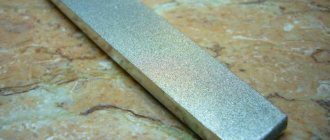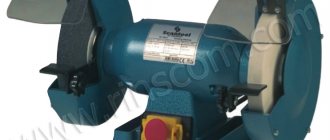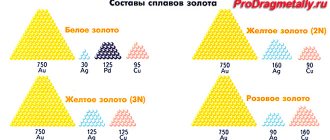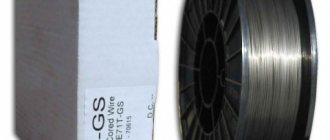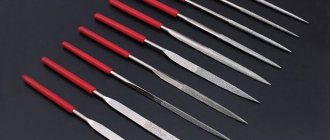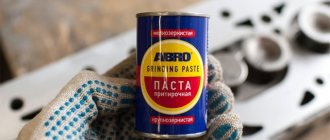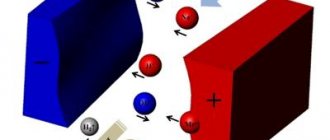Definition and purpose
When considering the question of what a needle file is, attention should be paid to the fact that the shape of the working part may differ significantly. An experienced master, as a rule, has a whole range of tools in his assortment. The efficiency of processing is associated with double notches, one of which is the main one, and the second is auxiliary.
Do not forget that a needle file is a tool with a handle on which the notch number is located. Recently, either one or two cross-cuts are applied to the surfaces. The main one is applied at an acute angle, it is responsible for removing metal, the auxiliary one is applied at 45° and is responsible for removing chips from the cutting zone. In accordance with GOST, carbon tool steel (U8, U8A, U10, etc.) is used in production. This material has increased hardness, which increases the efficiency of material removal from the surface.
The quality of the working surface is important. Even minor defects can cause a decrease in the efficiency of the work being carried out.
The design features of the product include the presence of a working part and a handle, which is quite large. The shape of the working surface of the needle file can differ significantly, it all depends on the task at hand. Diamond needle files - their application is very extensive; due to the application of diamond sputtering, the scope of application of the tool is significantly expanded, as well as increased resistance to wear.
What is a file and what is it for?
A file is a universal metalworking tool. Allows you to solve a whole range of problems.
- Cleaning parts from rust.
- Removing dirt and paint from the surface of parts.
- Bringing the workpiece to the required size.
- Tool sharpening.
- Cleaning power contacts of electrical equipment from carbon deposits.
- Surface grinding.
What is such a tool? This is a small piece of metal with notches. At one end there is a shank for a handle made of wood or plastic.
When making files, they are guided by GOST 1465–59. It regulates the use of a certain type of metal in the production of these products:
- alloyed chromium steel (grade ШХ 15 or 13Х);
- improved unalloyed steel (grade U10A or U13A).
For high-quality processing of metal parts, there are metal files. Types of notches allow you to solve a wide range of problems. This includes processing not only high-strength alloys, but also working with ceramics, plastic, wood, rubber or leather. The requirements for precision and cleanliness of processing are also different.
Which notch to choose
- Simple (single). Suitable for processing soft metals or plastics. Such material is easily removed and can quickly clog the space between the notches. But not in this case.
- File with cross or double cut. Used for working with parts made of hard alloys. For example, cast iron, bronze.
- Rasp, dot notch. Based on the type of tooth, such a tool is called a rasp or hog file. It is always large in size (250–350 mm). Has a large notch. The shape is classified as semicircular, round or flat. Good for working with rubber, leather, wood. Not suitable for precision machining and grinding.
- There is an arc type of file notches. Used for processing wooden parts.
GOST 1465–59 regulates six numbers of notches:
- Large. These are No. 0 and 1. Used for rough surface treatment. Such a tool, also called a bastard file, removes a layer 0.05–0.1 mm thick in one pass. Not suitable for precision machining.
- Notches No. 2 and 3 allow you to work more accurately. Removes a layer of 0.02–0.06 mm. The processing accuracy will correspond to this parameter.
- Finish adjustment of the size is possible with notches No. 4 and 5. An accuracy of 0.01–0.005 mm is possible here. This is how much material is removed from the workpiece in one pass of the tool.
Now you can see that you can do quite a lot of work with this tool. It is unpretentious and versatile. Indispensable where a power tool is “powerless” and is always ready to help out a master in a difficult situation.
How to make a file handle
The handle of the tool should be comfortable. It’s easy to make with your own hands from wood. The sequence is:
- Plan or turn the handle on a lathe. Each master selects the size and shape individually. It should fit well in the locksmith's hand. The wood is taken dried, of medium density, non-fragile. The best option is pine.
- Finally, place a metal ring where the file shank will be inserted. It can be made by cutting 1 cm from a tube of suitable diameter. Without it, when placing the handle on the shank, the handle will crack.
- Drill a hole along the axis of the handle from the side of the ring to a depth equal to ¾ of the length of the file shank. The drill bit should have a diameter of ½ of the average shank thickness.
- When inserting the handle, make sure that the axes of the two parts coincide.
Often it is necessary to process shaped surfaces with curves and sharp internal corners. To perform each of these works, select the appropriate tool, produced in accordance with GOST.
Types of needle file profiles
There are a variety of types of needle files, their scope largely depends on the task at hand. Recently, diamond-coated needle files have become widespread. They are characterized by increased resistance to mechanical stress. There are the following versions of the instrument:
- Straight single-ended. This design option is characterized by a long cylindrical shank with notches along the edges.
- Double-ended is characterized by having two ends with notches. Due to this, the product can be used to process the most complex surfaces.
- Transverse ones can be made in a variety of forms. An example is a groove file. The grooves have very different shapes, which is why quite a lot of problems can arise with cutting them.
- As previously noted, diamond options are very common. In this case, the grain size of diamond tools can vary significantly; the choice is made depending on the required performance and the hardness of the surface layer.
There are simply a huge number of different sets of needle files on sale, when purchasing which you need to pay a lot of attention to the quality of each product, as well as the packaging. In addition, when purchasing this type of tool, attention is paid to what kind of work needs to be done.
What material is it made from?
For the manufacture of tools, alloy steel with a high admixture of chromium (ШХ-15, 13Х) or with a high carbon content (У10А, У13А) is used.
Products with diamond coating according to the standard (GOST 1435, GOST 5950) must contain steel containing a high carbon number. The hardness of the material on the HRC scale corresponds to the range of 50-60 units.
When choosing such a tool, grain size is also taken into account. It determines the parameters of diamond coating particles. Information is applied in the form of markings on the handle (colored stripe or small marks).
| Type of marking | Grit Indicators |
| Two marks or one red stripe | 160/125-100/80 |
| One line or blue stripe | 80/63-63/55 |
| Lack of decals | 50/40-40/28 |
To make the handle, choose plastic or wood. Markings are applied to the surface of the pen, which encrypts information about the product (material type, grain size, size).
Modernized
A special group includes modernized needle files, which are made electrically. They greatly simplify the work, but are extremely rare on sale. The third purpose is to treat hard-to-reach places. The features include the following points:
- The device can be used in a variety of modes.
- The working part is driven by an installed engine, as well as a small gear.
In general, we can say that electric ones are the most attractive and are designed for a wide variety of work.
In addition, there are also pneumatic needle files. Their key points are:
- They are widely used in the automotive industry. In addition, it is installed on production lines.
- The pneumatic drive allows processing of small products.
- The force is transmitted through air, which is compressed and pressurized.
Pneumatics are considered reliable and productive. These types of tools often come with a variety of quick-release attachments designed to handle a variety of jobs.
What is the difference between a needle file and a rasp?
A rasp is simply a similar name to a needle file, but they have nothing in common except that they belong to the category of a processed tool called files.
What is the difference between them and how can they differ?
The answer is simple - by its purpose.
A rasp is a large file, and it is intended for general carpentry and plumbing work.
Particularly for processing soft metals, rubber, wood and leather.
Needle files – designed for fine work, for smoother and more precise filing.
Types of material
Classification is also carried out according to the type of material used in the manufacture of the working part. The classification is as follows:
- Diamond needle files are suitable for working with glass and ceramics. Such materials are characterized by high hardness and low machinability. It is worth considering that such coating has nothing to do with diamonds, since the production uses crumbs of a special artificial stone. Low grain size allows you to obtain a surface with low roughness. In this case, the grain size can vary significantly, it all depends on what result needs to be achieved after the work.
- Fog-shaped needle files are often used in the manufacture of jewelry and allow you to obtain an accurate shape. In most cases, the main part is made of high-strength tool steel, which is characterized by an increased degree of wear resistance. The working part is semicircular on both sides and slightly narrows at both ends, thereby expanding the scope of application.
Many manufacturers indicate what materials are used in the manufacture of the main part. This is due to the fact that such information is considered the most important, since soft alloys cause rapid surface wear.
Classification by section shape
The form determined the name and purpose of the files, and the main classification was created on it. Depending on the profile of the surface being processed, the cross-section of the tool is selected. Manufacturers of files suggest using special hand tools with the following sections:
- Flat – files of this shape are suitable for processing flat and rounded (protruding) surfaces. This is the most common cross-section for such a tool.
- Square files are used for processing rectangular and square holes. They grind rectangular grooves on the surface.
- Round - they are used to process internal cavities and holes, remove sagging from welds and flash from castings. The desired configuration is achieved by finishing elliptical surfaces inside the part.
- Triangular - in cross-section they represent a regular triangle with an angle of inclination of the surfaces of 60 ⁰ to each other. Most often, such a tool is used to sharpen the teeth of another tool, for example, a hacksaw for sawing wood.
- Special - at some enterprises, specially shaped files are made in tool shops. For example, in the manufacture of air-cooled two-stroke internal combustion engines, the inlet ports must be modified. The blanks are produced by casting, but finishing is done manually (cheaper than using a specialized machine).
- Oval or semi-cylindrical files are used for processing cylindrical or conical cavities.
Depending on the size of the parts being processed, hand tools are made in different lengths. When steam locomotives were used, each crew of drivers had a file 720 mm long. Used to clean soot and other contaminants from the surface of steam boiler pipes.
Modern files are rarely made longer than 500 mm (the size is determined by the length of the working part where the teeth are). For small jobs, for example, watchmakers use needle files with a working length of about 50 mm.
There is an accepted rule: the larger the tooth, the longer the working part. The explanation is quite simple. The work is performed in a forward motion. By moving the working part further, we achieve deeper removal of the layer when grinding.
Large teeth leave deep marks on the treated surface. To achieve a better surface, allowance is left to obtain a high-quality surface. It is obtained by processing using files with smaller teeth.
Using velvet files, you get a shiny surface with a minimum amount of scratches. Subsequent polishing is done using other tools. In practice, processing is carried out in several stages (at least two). The first is processing with a rough tool, the second is finishing surfaces.
Types of faces
Classification is also carried out according to the type of edges. They largely determine what type of processing can be carried out. The following are quite widespread:
- Wedge-shaped are characterized by a sharp ending. Distinctive features are the presence of two sharp edges, as well as an edge, due to which processing is ensured. This group is divided into two main types: with a sharp or rounded edge. When using the tool, small corners of parts can be processed.
- Needle ones differ from other designs in that they are small in size. The length of the working surface, as a rule, varies from 25 to 35 mm. This tool is found relatively rarely, this is due to the fact that it is quite specific in application and is suitable for precise work. The shank in this case is made in a square shape. Most often, needle-type designs are used to work with gold jewelry.
- Velvet files are characterized by the fact that there are about 25-80 teeth per centimeter. Due to this, it is possible to carry out the most delicate work, since only 0.05 mm is removed in one pass. After using such a tool, it is possible to obtain a surface without streaks and other defects.
Tools are classified according to the type of edges quite often. The cost of some is quite high due to the complexity of production.
Shapes and sizes of needle files
As has already become clear from the previous sections, the shapes and sizes of needle files can be different.
Experienced craftsmen have in their arsenal a large assortment of tools designed for individual and sequential processing of metal products and other workpieces made of various materials.
Files of various shapes are used mainly for finishing small parts.
Thanks to the mini file, you can process the most complex shapes and grind parts to perfection.
State Standards
The shapes of the file are established by state standards; this parameter is very important, since it is from it that you can find out about the purpose of a particular file.
1. Flat, blunt -nosed mini files have a rectangular shape and four working sides, with two edges of the product surface being wide and two narrow.
The wide sides are intended for processing smooth surfaces, while the narrow edges are used for processing grooves and other hard-to-reach places.
2. Flat pointed files have a slightly modified shape, namely a sharp end of the working part.
There are no other differences from the blunt-nosed models.
3. Diamond needle files have a diamond shape and blunt top corners.
The edges of the tool form sharp corners, which are the working part of the file.
This type of tool is used for processing parts whose sides have different angles.
4. Square tool models have a cross-section corresponding to the name, and are used for filing rectangular grooves, corner notches and backlashes.
A distinctive feature of this type of tool is that all edges and sides of the product are working.
5. Pointed triangular needle files have three equal sides and a sharp tip.
All three faces of this tool are working.
Triangular needle files are used to work with external and internal grooves of small parts.
6. Obtuse triangular needle files come in two types - three-sided and one-sided.
Triangular single-sided mini files have only one working edge.
Three-sided triangular needle files are a very popular type because they have three working edges and each of them is different.
7. Round models have a sharp tip.
The notches are located over the entire surface of the working part.
Use a round file to grind round surfaces and relief parts.
8. Semicircular file models have two working sides, on one side the file is oval, on the other - flat.
The peculiarity of this type is that in operation it takes the form of a segment in cross-section.
Both sides of the file have notches.
The oval side is used to process round reliefs of an object, the flat part helps in filing smooth surfaces and grooves.
For example, a fogol needle file has this shape.
9. Oval variants have an oval cross-section and pointed noses.
All sides of the file are involved in the work.
Used for processing rounded parts.
10. Knife- shaped is made in the shape of a knife, which is where it gets its name.
They are used for fine processing of parts, cleaning them from various contaminants, including rust, as well as for adjusting them to the desired characteristics.
Dimensions
All needle files have measured lengths: 80, 120 and 160 mm, as well as different cross-sectional shapes.
State Standards
A wide variety of standards must be applied when making a tool. An example is the following information:
- For flat ones, GOST 1513-77 is used, which indicates the scope of application and other characteristics.
- There are also round versions that are suitable for working with complex products.
There is also a diamond GOST 23461-84 version, which today is often used for processing various workpieces.
Download GOST 1513-77
Download GOST 23461-84
The GOST needle file eliminates the possibility that the product will not have the required characteristics. GOST 1513-77 is used in the manufacture of most versions.
How to sharpen a hacksaw with a file
The choice of file depends on the type of hacksaw teeth. The latter are of three types:
• for longitudinal cutting; • for transverse; • for universal.
Longitudinal hacksaws are worked with a diamond-shaped tool or a needle file.
Transverse files are worked with triangular files with a fine notch.
For universal ones, diamond-shaped “fine-grained” or coarse needle files are suitable.
The sharpening angle is within 30-60 degrees, depending on the material of the teeth.
When working, you need to build on the parameters of the teeth - angle, radius and height.
If the height becomes small during operation of the saw, it is first increased by cuts.
It is very important to repeat the original profile when sharpening. To work, you must firmly secure the hacksaw in a vice.
To work, you need to firmly secure the hacksaw in a vice.
Some people prefer a vertical edge position, others prefer a vertical position.
It is important to work according to a double-sided sharpening scheme - first they pass along one side of the teeth, then along the other. For details on sharpening a hacksaw with a file, see here
For details on sharpening a hacksaw with a file, see here
Types of notches
The applied standards determine that there are 5 main groups based on the type of notches. In order to determine the type of notch on a tool, you need to study the information that is printed on the handle.
If the required information is not on the handle, then attention should be paid to another type of product, since there is a possibility that the tool was not manufactured in compliance with the established standards in GOST.
Needle file handle ensures comfortable operation
The handle can be made of wood, plastic or rubber-coated plastic. If it is not there, then you should make the part yourself.
The best option would be to turn and polish a wooden handle. A toothbrush base with a hole drilled and centered from the inside can replace a plastic handle.
The main criteria for the tool should be cost-effectiveness and convenience. This is when you will be able to work with it for a long time.
File selection process
When choosing the tool in question, it is recommended to be guided by a fairly large number of different recommendations. Let's take the following as an example:
- Attention is paid to the absence of manufacturing defects.
- The product is selected by the number of notches.
- The dimensions of the main part are also important. As the length of the workpiece increases, the working part increases.
- There should be no corrosion on the surface.
It is recommended to give preference to products made by well-known manufacturers. Their products often have the most attractive performance characteristics.
File - what kind of tool is it and its structural components
Different tools are used to process metal and wood workpieces. The main purpose of files is to grind off the top layer from metal and wooden workpieces. Even children are familiar with the design of this device, since the tool is a metal multi-bladed bar of different shapes with a handle. For the manufacture of the bar, special grades of steel are used - ШХ15 and У10А. These are steels consisting of 1.1-1.25% carbon, that is, with a low carbon content. The outer surface of the metal part has notches through which the surface is ground.
The main structural elements of the device are:
- Steel beam - can have a rectangular, round, triangular shape, on the outer surface of which notches are applied. These notches are cutting edges that are used to grind off the metal layer. The notches form a corrugated surface (multi-blade part), which allows for high precision when processing parts.
- Handle - used to control the tool. Wood or plastic is used for its production (metal handles are very rare). Modern files are equipped with fiberglass handles. The handle is attached to a metal bar through a cone-shaped shank. If the handle fails, it can be replaced, which is one of the most important advantages of files
If you look at the photo of the tool, in addition to the main structural parts, it consists of many auxiliary elements:
- Edges are notches on the working base of the tool. They are the ones who make a file from a piece of metal, which is used to perform a number of different functions.
- Ribs are the sides of the metal base, which also have notches. Using these notches you can saw off workpieces
- The toe is the end or front part of the device. It has a blunt, tapered shape
- The heel is the back part on which there are no notches. The heel connects the blade to the shank
- Shank - a narrowed cone-shaped part through which the handle is attached to the metal part
The simplest design of the tool allows it to be used to solve the following problems:
- Reducing the edges of various parts and workpieces, which is carried out in order to adjust them to the required dimensions
- Removing dirt and rust from the surface of parts and workpieces
- Sharpening of various tools and equipment
- Grinding parts to appropriate roughness levels
- Cutting off workpieces - can be used as a cutting tool
- Making chamfers, splines, radii and grooves
There is one secret that will help every craftsman when it is necessary to obtain a hole of the required diameter. If you don’t have a drill of the required diameter at hand, a round file will help you get the appropriate hole size. To do this, you need to pre-drill a hole of the same diameter as the drill available. After this, using a file, the diameter is increased to the desired size.
The production of files is carried out in compliance with the relevant requirements. These requirements are provided for by GOST 1465-80. The main requirement stipulated by GOST is to ensure high hardness of the metal base of the tool. To achieve high strength parameters, the metal base is subjected to heat treatment without tempering. In this case, a tool hardness corresponding to values of at least 54-58 HRC is achieved.
This is interesting!
A nail file is the closest relative of a carpenter's file. Tools are designed to perform similar actions, but they process different types of materials.
Using a needle file
Only proper use of a needle file can significantly extend its service life. Among the recommendations we note:
- Do not treat over an oil stain; contact with lubricants is prohibited.
- Do not forget that the product is not designed to withstand high mechanical stress.
- It is worth considering that processing hard alloys, if the working part is not intended for this, leads to rapid wear of the cutting edges. Alloys that are too soft can cause chips to clog.
After using the tool, you should clean it. In addition, it is prohibited to place a file on metal parts or apply impact loads. Even a minor chip causes a significant reduction in service life and basic qualities.
What kind of work are tools used for depending on the size of the teeth?
Tools with large teeth are needed for working with large surfaces or where large layers of metal must be removed. For example, such work can be done with a file with three edges and a large notch.
A medium-sized notch is more suitable for working with soft metals: brass, aluminum, bronze. Such needle files do an excellent job of polishing water pipe couplings for their optimal joining or removing nicks without “licking” the product.
The smallest teeth are designed for filigree work. The tools are able to enlarge the wedge groove on the electric motor shaft. They can clean burnt contacts of current collectors used in everyday life (sockets, circuit breakers, etc.).
There is a special notch that is located along the body of the device, and not transversely, as is customary. In this case, the cross-section of the canvas has a round shape. This diamond needle file is used for sharpening knives at home. It has its own name - musat. Sharpening proceeds more accurately and also much faster than with sandpaper.
On the market you can also see needle files of unusual shapes, which are extremely rare. They have a curved shape. Tools are used for processing internal curved grooves. As a rule, such devices have a notch on both ends of the instrument, and the handle is located in the middle.
